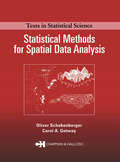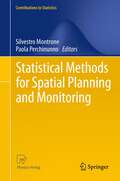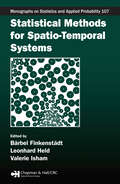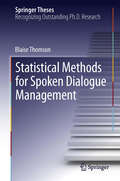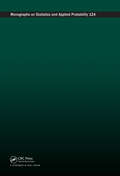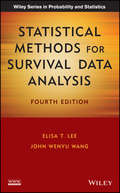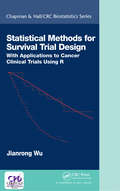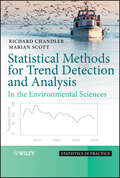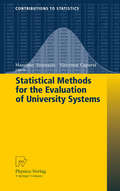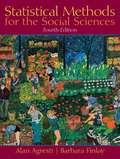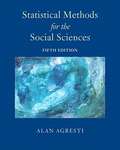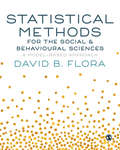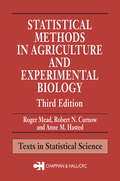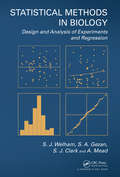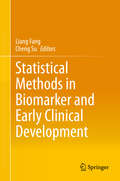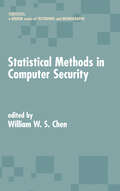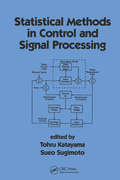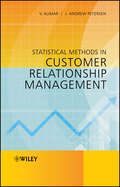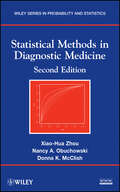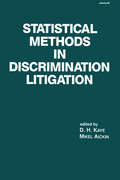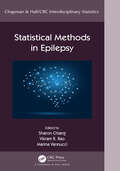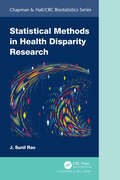- Table View
- List View
Statistical Methods for Spatial Data Analysis (Chapman & Hall/CRC Texts in Statistical Science)
by Carol A. Gotway Oliver SchabenbergerUnderstanding spatial statistics requires tools from applied and mathematical statistics, linear model theory, regression, time series, and stochastic processes. It also requires a mindset that focuses on the unique characteristics of spatial data and the development of specialized analytical tools designed explicitly for spatial data analysis. Statistical Methods for Spatial Data Analysis answers the demand for a text that incorporates all of these factors by presenting a balanced exposition that explores both the theoretical foundations of the field of spatial statistics as well as practical methods for the analysis of spatial data. This book is a comprehensive and illustrative treatment of basic statistical theory and methods for spatial data analysis, employing a model-based and frequentist approach that emphasizes the spatial domain. It introduces essential tools and approaches including: measures of autocorrelation and their role in data analysis; the background and theoretical framework supporting random fields; the analysis of mapped spatial point patterns; estimation and modeling of the covariance function and semivariogram; a comprehensive treatment of spatial analysis in the spectral domain; and spatial prediction and kriging. The volume also delivers a thorough analysis of spatial regression, providing a detailed development of linear models with uncorrelated errors, linear models with spatially-correlated errors and generalized linear mixed models for spatial data. It succinctly discusses Bayesian hierarchical models and concludes with reviews on simulating random fields, non-stationary covariance, and spatio-temporal processes.Additional material on the CRC Press website supplements the content of this book. The site provides data sets used as examples in the text, software code that can be used to implement many of the principal methods described and illustrated, and updates to the text itself.
Statistical Methods for Spatial Planning and Monitoring
by Silvestro Montrone Paola PerchinunnoThe book aims to investigate methods and techniques for spatial statistical analysis suitable to model spatial information in support of decision systems. Over the last few years there has been a considerable interest in these tools and in the role they can play in spatial planning and environmental modelling. One of the earliest and most famous definition of spatial planning was "a geographical expression to the economic, social, cultural and ecological policies of society": borrowing from this point of view, this text shows how an interdisciplinary approach is an effective way to an harmonious integration of national policies with regional and local analysis. A wide range of spatial models and techniques is, also, covered: spatial data mining, point processes analysis, nearest neighbor statistics and cluster detection, Fuzzy Regression model and local indicators of spatial association; all of these tools provide the policy-maker with a valuable support to policy development.
Statistical Methods for Spatio-Temporal Systems
by Leonhard Held Valerie Isham Bärbel FinkenstädtStatistical Methods for Spatio-Temporal Systems presents current statistical research issues on spatio-temporal data modeling and will promote advances in research and a greater understanding between the mechanistic and the statistical modeling communities.Contributed by leading researchers in the field, each self-contained chapter starts w
Statistical Methods for Spoken Dialogue Management
by Blaise ThomsonSpeech is the most natural mode of communication and yet attempts to build systems which support robust habitable conversations between a human and a machine have so far had only limited success. A key reason is that current systems treat speech input as equivalent to a keyboard or mouse, and behaviour is controlled by predefined scripts that try to anticipate what the user will say and act accordingly. But speech recognisers make many errors and humans are not predictable; the result is systems which are difficult to design and fragile in use. Statistical methods for spoken dialogue management takes a radically different view. It treats dialogue as the problem of inferring a user's intentions based on what is said. The dialogue is modelled as a probabilistic network and the input speech acts are observations that provide evidence for performing Bayesian inference. The result is a system which is much more robust to speech recognition errors and for which a dialogue strategy can be learned automatically using reinforcement learning. The thesis describes both the architecture, the algorithms needed for fast real-time inference over very large networks, model parameter estimation and policy optimisation. This ground-breaking work will be of interest both to practitioners in spoken dialogue systems and to cognitive scientists interested in models of human behaviour.
Statistical Methods for Stochastic Differential Equations (Chapman & Hall/CRC Monographs on Statistics and Applied Probability)
by Mathieu Kessler Alexander Lindner Michael SorensenThe seventh volume in the SemStat series, Statistical Methods for Stochastic Differential Equations presents current research trends and recent developments in statistical methods for stochastic differential equations. Written to be accessible to both new students and seasoned researchers, each self-contained chapter starts with introductions to th
Statistical Methods for Survival Data Analysis
by John Wenyu Wang Elisa T. LeePraise for the Third Edition". . . an easy-to read introduction to survival analysis which covers the major concepts and techniques of the subject." --Statistics in Medical ResearchUpdated and expanded to reflect the latest developments, Statistical Methods for Survival Data Analysis, Fourth Edition continues to deliver a comprehensive introduction to the most commonly-used methods for analyzing survival data. Authored by a uniquely well-qualified author team, the Fourth Edition is a critically acclaimed guide to statistical methods with applications in clinical trials, epidemiology, areas of business, and the social sciences. The book features many real-world examples to illustrate applications within these various fields, although special consideration is given to the study of survival data in biomedical sciences.Emphasizing the latest research and providing the most up-to-date information regarding software applications in the field, Statistical Methods for Survival Data Analysis, Fourth Edition also includes:Marginal and random effect models for analyzing correlated censored or uncensored dataMultiple types of two-sample and K-sample comparison analysisUpdated treatment of parametric methods for regression model fitting with a new focus on accelerated failure time modelsExpanded coverage of the Cox proportional hazards modelExercises at the end of each chapter to deepen knowledge of the presented materialStatistical Methods for Survival Data Analysis is an ideal text for upper-undergraduate and graduate-level courses on survival data analysis. The book is also an excellent resource for biomedical investigators, statisticians, and epidemiologists, as well as researchers in every field in which the analysis of survival data plays a role.
Statistical Methods for Survival Trial Design: With Applications to Cancer Clinical Trials Using R (Chapman & Hall/CRC Biostatistics Series)
by Jianrong WuStatistical Methods for Survival Trial Design: With Applications to Cancer Clinical Trials Using R provides a thorough presentation of the principles of designing and monitoring cancer clinical trials in which time-to-event is the primary endpoint. Traditional cancer trial designs with time-to-event endpoints are often limited to the exponential model or proportional hazards model. In practice, however, those model assumptions may not be satisfied for long-term survival trials. This book is the first to cover comprehensively the many newly developed methodologies for survival trial design, including trial design under the Weibull survival models; extensions of the sample size calculations under the proportional hazard models; and trial design under mixture cure models, complex survival models, Cox regression models, and competing-risk models. A general sequential procedure based on the sequential conditional probability ratio test is also implemented for survival trial monitoring. All methodologies are presented with sufficient detail for interested researchers or graduate students.
Statistical Methods for Trend Detection and Analysis in the Environmental Sciences (Statistics In Practice Ser. #105)
by Richard Chandler Marian ScottThe need to understand and quantify change is fundamental throughout the environmental sciences. This might involve describing past variation, understanding the mechanisms underlying observed changes, making projections of possible future change, or monitoring the effect of intervening in some environmental system. This book provides an overview of modern statistical techniques that may be relevant in problems of this nature. Practitioners studying environmental change will be familiar with many classical statistical procedures for the detection and estimation of trends. However, the ever increasing capacity to collect and process vast amounts of environmental information has led to growing awareness that such procedures are limited in the insights that they can deliver. At the same time, significant developments in statistical methodology have often been widely dispersed in the statistical literature and have therefore received limited exposure in the environmental science community. This book aims to provide a thorough but accessible review of these developments. It is split into two parts: the first provides an introduction to this area and the second part presents a collection of case studies illustrating the practical application of modern statistical approaches to the analysis of trends in real studies. Key Features: Presents a thorough introduction to the practical application and methodology of trend analysis in environmental science. Explores non-parametric estimation and testing as well as parametric techniques. Methods are illustrated using case studies from a variety of environmental application areas. Looks at trends in all aspects of a process including mean, percentiles and extremes. Supported by an accompanying website featuring datasets and R code. The book is designed to be accessible to readers with some basic statistical training, but also contains sufficient detail to serve as a reference for practising statisticians. It will therefore be of use to postgraduate students and researchers both in the environmental sciences and in statistics.
Statistical Methods for the Evaluation of University Systems
by Vincenza Capursi Massimo AttanasioThis book presents a collection of statistical methods and procedures to assess data coming from educational systems. The topics examined include: statistical methods for constructing composite indicators, applied measurements, assessment of educational systems, measurement of the performance of the students at Italian universities, and statistical modeling for questionnaire data. Other issues are the implications of introducing different assessment criteria and procedures to the Italian university system.
Statistical Methods for the Information Professional: A Practical, Painless Approach to Understanding, Using, and Interpreting Statistics (Asist Monograph Ser.)
by Liwen VaughanIn this unique and useful book, the author clearly explains the statistical methods used in information science research, focusing on basic logic rather than mathematical intricacies. Her emphasis is on the meaning of statistics, when and how to apply them, and how to interpret the results of statistical analysis. Through the use of real-world examples, she shows how statistics can be used to improve services, make better decisions, and conduct more effective research. More than 80 helpful figures and tables, seven appendices, bibliography, and an index are included.
Statistical Methods for the Social Sciences
by Alan Agresti Barbara FinlayThe book presents an introduction to statistical methods for students majoring in social science disciplines. No previous knowledge of statistics is assumed, and mathematical background is assumed to be minimal (lowest-level high-school algebra).
Statistical Methods for the Social Sciences
by Alan AgrestiStatistical methods applied to social sciences, made accessible to all through an emphasis on concepts Statistical Methods for the Social Sciences introduces statistical methods to students majoring in social science disciplines. With an emphasis on concepts and applications, this book assumes you have no previous knowledge of statistics and only a minimal mathematical background. It contains sufficient material for a two-semester course. The 5th Edition gives you examples and exercises with a variety of “real data.” It includes more illustrations of statistical software for computations and takes advantage of the outstanding applets to explain key concepts, such as sampling distributions and conducting basic data analyses. It continues to downplay mathematics–often a stumbling block for students–while avoiding reliance on an overly simplistic recipe-based approach to statistics.
Statistical Methods for the Social and Behavioural Sciences: A Model-Based Approach
by David B. FloraStatistical methods in modern research increasingly entail developing, estimating and testing models for data. Rather than rigid methods of data analysis, the need today is for more flexible methods for modelling data. In this logical, easy-to-follow and exceptionally clear book, David Flora provides a comprehensive survey of the major statistical procedures currently used. His innovative model-based approach teaches you how to: Understand and choose the right statistical model to fit your data Match substantive theory and statistical models Apply statistical procedures hands-on, with example data analyses Develop and use graphs to understand data and fit models to data Work with statistical modeling principles using any software package Learn by applying, with input and output files for R, SAS, SPSS, and Mplus. Statistical Methods for the Social and Behavioural Sciences: A Model Based Approach is the essential guide for those looking to extend their understanding of the principles of statistics, and begin using the right statistical modeling method for their own data. It is particularly suited to second or advanced courses in statistical methods across the social and behavioural sciences.
Statistical Methods for the Social and Behavioural Sciences: A Model-Based Approach
by David B. FloraStatistical methods in modern research increasingly entail developing, estimating and testing models for data. Rather than rigid methods of data analysis, the need today is for more flexible methods for modelling data. In this logical, easy-to-follow and exceptionally clear book, David Flora provides a comprehensive survey of the major statistical procedures currently used. His innovative model-based approach teaches you how to: Understand and choose the right statistical model to fit your data Match substantive theory and statistical models Apply statistical procedures hands-on, with example data analyses Develop and use graphs to understand data and fit models to data Work with statistical modeling principles using any software package Learn by applying, with input and output files for R, SAS, SPSS, and Mplus. Statistical Methods for the Social and Behavioural Sciences: A Model Based Approach is the essential guide for those looking to extend their understanding of the principles of statistics, and begin using the right statistical modeling method for their own data. It is particularly suited to second or advanced courses in statistical methods across the social and behavioural sciences.
Statistical Methods in Agriculture and Experimental Biology (Texts in Statistical Science)
by Roger MeadThe third edition of this popular introductory text maintains the character that won worldwide respect for its predecessors but features a number of enhancements that broaden its scope, increase its utility, and bring the treatment thoroughly up to date. It provides complete coverage of the statistical ideas and methods essential to students in agriculture or experimental biology. In addition to covering fundamental methodology, this treatment also includes more advanced topics that the authors believe help develop an appreciation of the breadth of statistical methodology now available. The emphasis is not on mathematical detail, but on ensuring students understand why and when various methods should be used.New in the Third Edition:A chapter on the two simplest yet most important methods of multivariate analysisIncreased emphasis on modern computer applications Discussions on a wider range of data types and the graphical display of dataAnalysis of mixed cropping experiments and on-farm experiments
Statistical Methods in Biology: Design and Analysis of Experiments and Regression
by A. Mead S.J. Welham S.A. Gezan S.J. ClarkWritten in simple language with relevant examples, this illustrative introductory book presents best practices in experimental design and simple data analysis. Taking a practical and intuitive approach, it only uses mathematical formulae to formalize the methods where necessary and appropriate. The text features extended discussions of examples that include real data sets arising from research. The authors analyze data in detail to illustrate the use of basic formulae for simple examples while using the GenStat statistical package for more complex examples. Each chapter offers instructions on how to obtain the example analyses in GenStat and R.
Statistical Methods in Biomarker and Early Clinical Development
by Liang Fang Cheng SuThis contributed volume offers a much-needed overview of the statistical methods in early clinical drug and biomarker development. Chapters are written by expert statisticians with extensive experience in the pharmaceutical industry and regulatory agencies. Because of this, the data presented is often accompanied by real world case studies, which will help make examples more tangible for readers. The many applications of statistics in drug development are covered in detail, making this volume a must-have reference.Biomarker development and early clinical development are the two critical areas on which the book focuses. By having the two sections of the book dedicated to each of these topics, readers will have a more complete understanding of how applying statistical methods to early drug development can help identify the right drug for the right patient at the right dose. Also presented are exciting applications of machine learning and statistical modeling, along with innovative methods and state-of-the-art advances, making this a timely and practical resource.This volume is ideal for statisticians, researchers, and professionals interested in pharmaceutical research and development. Readers should be familiar with the fundamentals of statistics and clinical trials.
Statistical Methods in Computer Security (Statistics: A Series of Textbooks and Monographs)
by William W. S. ChenStatistical Methods in Computer Security summarizes discussions held at the recent Joint Statistical Meeting to provide a clear layout of current applications in the field. This blue-ribbon reference discusses the most influential advancements in computer security policy, firewalls, and security issues related to passwords. It addresses crime and m
Statistical Methods in Control & Signal Processing (Electrical and Computer Engineering)
by Tohru Katayama Sueo SugimotoPresenting statistical and stochastic methods for the analysis and design of technological systems in engineering and applied areas, this work documents developments in statistical modelling, identification, estimation and signal processing. The book covers such topics as subspace methods, stochastic realization, state space modelling, and identification and parameter estimation.
Statistical Methods in Customer Relationship Management
by V. Kumar J. Andrew PetersenStatistical Methods in Customer Relationship Management focuses on the quantitative and modeling aspects of customer management strategies that lead to future firm profitability, with emphasis on developing an understanding of Customer Relationship Management (CRM) models as the guiding concept for profitable customer management. To understand and explore the functioning of CRM models, this book traces the management strategies throughout a customer's tenure with a firm. Furthermore, the book explores in detail CRM models for customer acquisition, customer retention, customer acquisition and retention, customer churn, and customer win back.Statistical Methods in Customer Relationship Management:Provides an overview of a CRM system, introducing key concepts and metrics needed to understand and implement these models.Focuses on five CRM models: customer acquisition, customer retention, customer churn, and customer win back with supporting case studies.Explores each model in detail, from investigating the need for CRM models to looking at the future of the models.Presents models and concepts that span across the introductory, advanced, and specialist levels.Academics and practitioners involved in the area of CRM as well as instructors of applied statistics and quantitative marketing courses will benefit from this book.
Statistical Methods in Diagnostic Medicine
by Xiao-Hua Zhou Nancy A. Obuchowski Donna K. McclishA new edition of the cutting-edge guide to diagnostic tests in medical research In recent years, a considerable amount of research has focused on evolving methods for designing and analyzing diagnostic accuracy studies. Statistical Methods in Diagnostic Medicine, Second Edition continues to provide a comprehensive approach to the topic, guiding readers through the necessary practices for understanding these studies and generalizing the results to patient populations. Following a basic introduction to measuring test accuracy and study design, the authors successfully define various measures of diagnostic accuracy, describe strategies for designing diagnostic accuracy studies, and present key statistical methods for estimating and comparing test accuracy. Topics new to the Second Edition include: Methods for tests designed to detect and locate lesions Recommendations for covariate-adjustment Methods for estimating and comparing predictive values and sample size calculations Correcting techniques for verification and imperfect standard biases Sample size calculation for multiple reader studies when pilot data are available Updated meta-analysis methods, now incorporating random effects Three case studies thoroughly showcase some of the questions and statistical issues that arise in diagnostic medicine, with all associated data provided in detailed appendices. A related web site features Fortran, SAS®, and R software packages so that readers can conduct their own analyses. Statistical Methods in Diagnostic Medicine, Second Edition is an excellent supplement for biostatistics courses at the graduate level. It also serves as a valuable reference for clinicians and researchers working in the fields of medicine, epidemiology, and biostatistics.
Statistical Methods in Discrimination Litigation (Statistics: A Series of Textbooks and Monographs)
by D.H. Kaye Mickel AickinThis book sketches some of the legal doctrines that underlie discrimination litigation. It describes and probes frequently seen statistical methods. The book also describes the more or less standard methods being brought into United States Supreme Court.
Statistical Methods in Drug Combination Studies (Chapman & Hall/CRC Biostatistics Series #69)
by Wei Zhao Harry YangThe growing interest in using combination drugs to treat various complex diseases has spawned the development of many novel statistical methodologies. The theoretical development, coupled with advances in statistical computing, makes it possible to apply these emerging statistical methods in in vitro and in vivo drug combination assessments. Howeve
Statistical Methods in Epilepsy (Chapman & Hall/CRC Interdisciplinary Statistics)
by Marina Vannucci Sharon Chiang Vikram R. RaoEpilepsy research promises new treatments and insights into brain function, but statistics and machine learning are paramount for extracting meaning from data and enabling discovery. Statistical Methods in Epilepsy provides a comprehensive introduction to statistical methods used in epilepsy research. Written in a clear, accessible style by leading authorities, this textbook demystifies introductory and advanced statistical methods, providing a practical roadmap that will be invaluable for learners and experts alike.Topics include a primer on version control and coding, pre-processing of imaging and electrophysiological data, hypothesis testing, generalized linear models, survival analysis, network analysis, time-series analysis, spectral analysis, spatial statistics, unsupervised and supervised learning, natural language processing, prospective trial design, pharmacokinetic and pharmacodynamic modeling, and randomized clinical trials.Features: Provides a comprehensive introduction to statistical methods employed in epilepsy research Divided into four parts: Basic Processing Methods for Data Analysis; Statistical Models for Epilepsy Data Types; Machine Learning Methods; and Clinical Studies Covers methodological and practical aspects, as well as worked-out examples with R and Python code provided in the online supplement Includes contributions by experts in the field The handbook targets clinicians, graduate students, medical students, and researchers who seek to conduct quantitative epilepsy research. The topics covered extend broadly to quantitative research in other neurological specialties and provide a valuable reference for the field of neurology.
Statistical Methods in Health Disparity Research (Chapman & Hall/CRC Biostatistics Series)
by J. Sunil RaoA health disparity refers to a higher burden of illness, injury, disability, or mortality experienced by one group relative to others attributable to multiple factors including socioeconomic status, environmental factors, insufficient access to health care, individual risk factors, and behaviors and inequalities in education. These disparities may be due to many factors including age, income, and race. Statistical Methods in Health Disparity Research will focus on their estimation, ranging from classical approaches including the quantification of a disparity, to more formal modeling, to modern approaches involving more flexible computational approaches. Features:• Presents an overview of methods and applications of health disparity estimation• First book to synthesize research in this field in a unified statistical framework• Covers classical approaches, and builds to more modern computational techniques• Includes many worked examples and case studies using real data• Discusses available software for estimation The book is designed primarily for researchers and graduate students in biostatistics, data science, and computer science. It will also be useful to many quantitative modelers in genetics, biology, sociology, and epidemiology.
